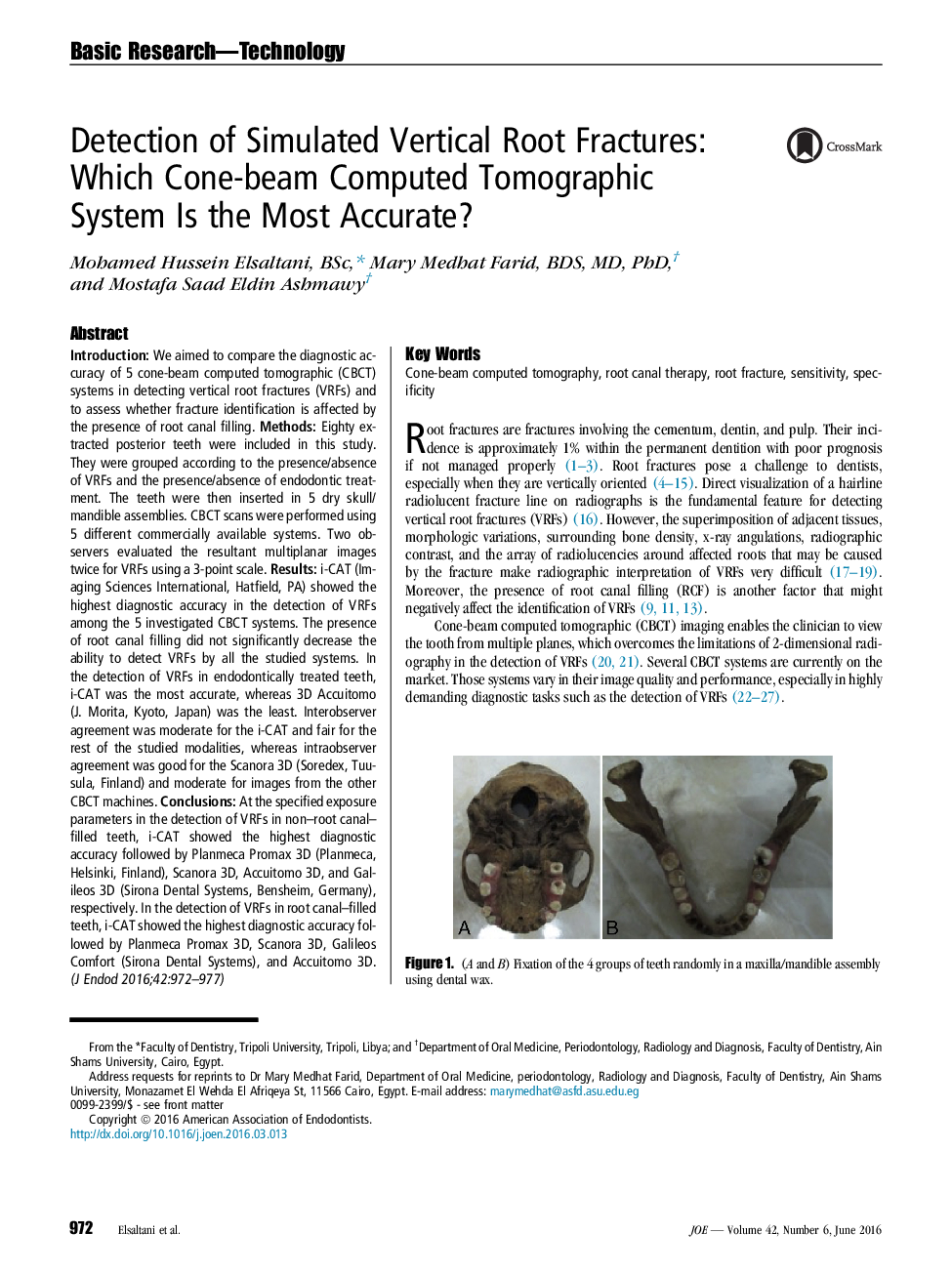| کد مقاله | کد نشریه | سال انتشار | مقاله انگلیسی | نسخه تمام متن |
|---|---|---|---|---|
| 3146521 | 1197289 | 2016 | 6 صفحه PDF | دانلود رایگان |
• i-CAT showed the highest diagnostic accuracy in the detection of vertical root fractures (VRFs) among the 5 investigated cone-beam computed tomographic (CBCT) systems.
• The presence of root canal filling did not significantly decrease the ability to detect vertical root fracture by all the studied systems.
• In the detection of VRFs in non–root canal–filled teeth; i-CAT showed the highest diagnostic accuracy followed by Planmeca Promax 3D, Scanora 3D, Accuitomo 3D, and Galileos 3D, respectively.
• In the detection of VRFs in endodontically treated teeth; i-CAT was the most accurate, whereas 3D Accuitomo was the least.
• Interobserver agreement was moderate for the i-CAT and fair for the rest of the studied modalities, whereas intraobserver agreement was good for the Scanora 3D and moderate for images from the other CBCT machines.
IntroductionWe aimed to compare the diagnostic accuracy of 5 cone-beam computed tomographic (CBCT) systems in detecting vertical root fractures (VRFs) and to assess whether fracture identification is affected by the presence of root canal filling.MethodsEighty extracted posterior teeth were included in this study. They were grouped according to the presence/absence of VRFs and the presence/absence of endodontic treatment. The teeth were then inserted in 5 dry skull/mandible assemblies. CBCT scans were performed using 5 different commercially available systems. Two observers evaluated the resultant multiplanar images twice for VRFs using a 3-point scale.Resultsi-CAT (Imaging Sciences International, Hatfield, PA) showed the highest diagnostic accuracy in the detection of VRFs among the 5 investigated CBCT systems. The presence of root canal filling did not significantly decrease the ability to detect VRFs by all the studied systems. In the detection of VRFs in endodontically treated teeth, i-CAT was the most accurate, whereas 3D Accuitomo (J. Morita, Kyoto, Japan) was the least. Interobserver agreement was moderate for the i-CAT and fair for the rest of the studied modalities, whereas intraobserver agreement was good for the Scanora 3D (Soredex, Tuusula, Finland) and moderate for images from the other CBCT machines.ConclusionsAt the specified exposure parameters in the detection of VRFs in non–root canal–filled teeth, i-CAT showed the highest diagnostic accuracy followed by Planmeca Promax 3D (Planmeca, Helsinki, Finland), Scanora 3D, Accuitomo 3D, and Galileos 3D (Sirona Dental Systems, Bensheim, Germany), respectively. In the detection of VRFs in root canal–filled teeth, i-CAT showed the highest diagnostic accuracy followed by Planmeca Promax 3D, Scanora 3D, Galileos Comfort (Sirona Dental Systems), and Accuitomo 3D.
Journal: Journal of Endodontics - Volume 42, Issue 6, June 2016, Pages 972–977
